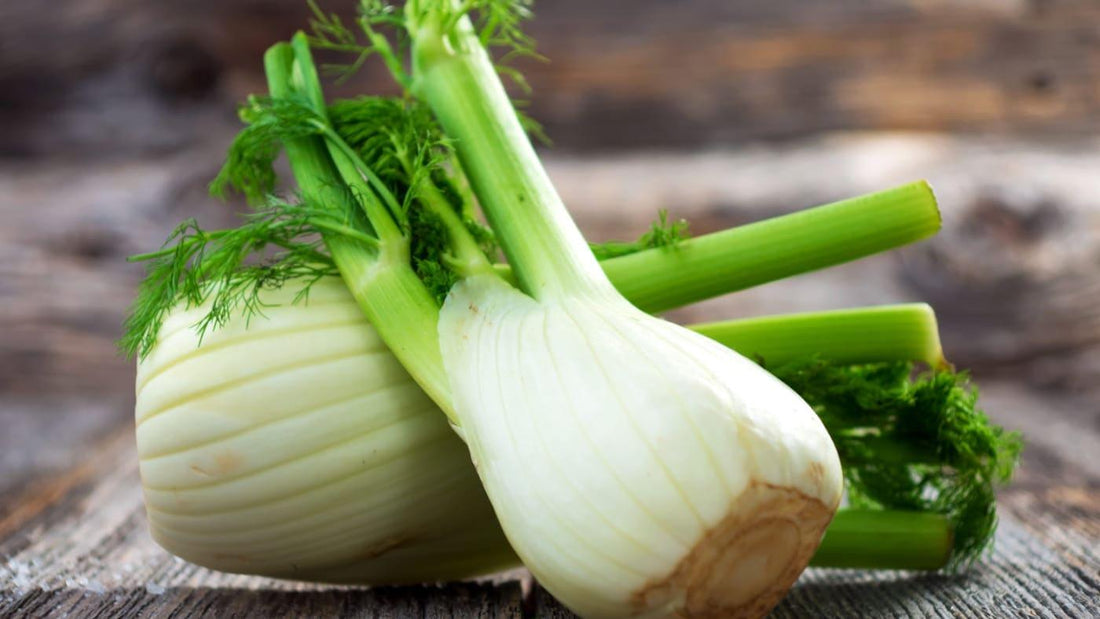Fennel is a unique-tasting herb which boasts a hint of aniseed flavor. This herb refers to the dill-like, delicate feathery foliage that sits on top of the bulb-like, white-green vegetable, of the same name.
This plant species, which is a member of the carrot family, is native to the Mediterranean coastline, although it can also be spotted growing near riverbanks & coasts all over the world.

An important addition to any kitchen, Fennel is another wonder herb which offers a double whammy - it jazzes up our dishes & boosts our health!
How Can I Use Fennel in My Cooking?
Chop the green fennel fronds to add a fabulous taste and a feel of freshness to salads, bean and lentil dishes, avocado, curries, soup, stock, salsa, sauces, sandwiches and wraps, pesto and vinaigrettes.

Fennel fronds are also a perfect topping for toast, stir-fries, and vegan-yogurt dips.
Fun Facts About Fennel
Did you know that the highly versatile fennel plant is cultivated for its edible seeds, leaves and shoots?
And are you aware of its strong aniseed flavor? - If not, then it's time to give it whirl!
Also, just to make things confusing, Fennel's light foliage is also known as: Fennel greens, Fennel tops, Fennel leaves, and Fennel fronds!
Once you get familiar with these names, then you won't get confused when you are looking through recipes!
Taste Variations
If you caramelize or roast fennel, it generates a natural sweet taste which counteracts its bitterness.

And just like the rest of the plant, the Fennel greens give off an aniseed flavor, yet, in this case, the texture is more delicate, and the taste is more green.
Preparing & Storing Fennel
Rinse, and then chop the whole leaves. - Of note, you can make use of the stalks as well as the leaves, as both are edible.
Any freshly cut fennel which is left over from the meal you are preparing, can be kept for up to three days in the fridge. Simply wrap it in damp kitchen paper and put it in a perforated bag prior to storing.

How About Making Some 'Delicious Fennel Fronds Pesto?'
Once people have made use of the fennel bulb, they are often unsure about how they can make use of the foliage.
So here is one solution! And you don't need many ingredients to put this freezer-friendly pesto with a difference, together, and the prep time is only 10 minutes!

Once it's ready to roll, you can use it in place of standard pesto. And on the bright side, Fennel Fronds Pesto can be frozen for around 4 months.
Ingredients
- 3 cups of Fennel Tops (Place loosely in the cup)
- 1 cup of walnuts (toasted)
- Half a cup of extra virgin olive oil
- 1 clove of garlic
- 1 juiced lemon
- Sea salt (1 teaspoon)
- Optional: if you would like a stronger flavor than the Fennel tops provide, simply add a small part of the fennel stalk
Instructions
Step 1: Place the walnuts on a medium heat for several minutes, until they are mildly toasted. - They key here, is to aim for a golden brown, as opposed to a darker color. Once you have achieved this, then set the skillet aside to allow the walnuts to cool.
Step 2: Now take you food processor, and put in the walnuts, garlic, lemon juice, fennel tops and salt. Now add a quarter of a cup of olive oil (half the quantity on the ingredients list), and blend or pulse until everything is properly mixed together.
Step 3: Carry on blending while you simultaneously add the remaining quarter of a cup of olive oil.
Step 4: Work the food processor until you achieve your preferred consistency. - Note: if you are aiming for a thinner consistency, then you may have to add one teaspoon of water (or olive oil), at a time, so you get the desired outcome.

Mega Health Benefits
According to science-backed research, when you add fennel to your food, you are:
- Boosting your heart health
- Ingesting important nutrients, including folate and potassium
- Gaining the benefits of an anti-inflammatory
- Supporting healthy skin
- Helping your weight management
- Ameliorating symptoms of anemia [1]
Fennel can also be good for: "various digestive problems including heartburn, intestinal gas, bloating, loss of appetite, and colic in infants. It is also used for upper respiratory tract infections, coughs, bronchitis, cholera, backache, bed-wetting, and visual problems" [2]. - Now that is quite a list!


